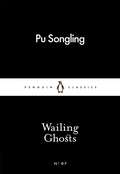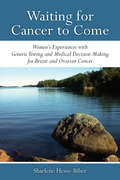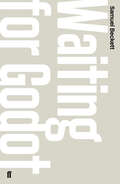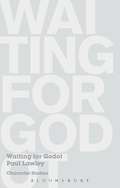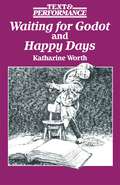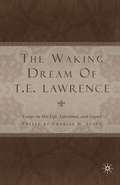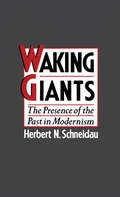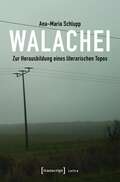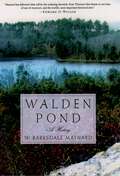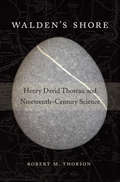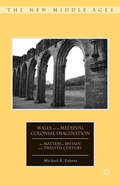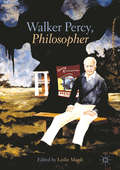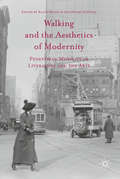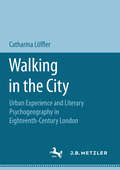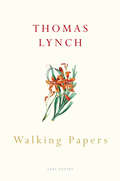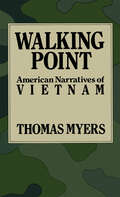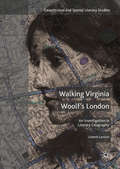- Table View
- List View
Wailing Ghosts (Penguin Little Black Classics)
by Pu Songling'...revealing great shining fangs more than three inches long.'Some of the most macabre and wonderful of all Chinese stories, including 'The Golden Goblet', 'Scorched Moth the Daoist' and 'The Black Beast'Introducing Little Black Classics: 80 books for Penguin's 80th birthday. Little Black Classics celebrate the huge range and diversity of Penguin Classics, with books from around the world and across many centuries. They take us from a balloon ride over Victorian London to a garden of blossom in Japan, from Tierra del Fuego to 16th century California and the Russian steppe. Here are stories lyrical and savage; poems epic and intimate; essays satirical and inspirational; and ideas that have shaped the lives of millions.Pu Songling (1640-1715). Pu Songling's Strange Tales from a Chinese Studio is available in Penguin Classics.
Waiting for Cancer to Come: Women’s Experiences with Genetic Testing and Medical Decision Making for Breast and Ovarian Cancer
by Sharlene Hesse-BiberWaiting for Cancer to Come tells the stories of women who are struggling with their high risk for cancer. Based on interviews and surveys of dozens of women, this book pieces together the diverse yet interlocking experiences of women who have tested positive for the BRCA 1/2 gene mutations, which indicate a higher risk of developing breast and ovarian cancer. Sharlene Hesse-Biber brings these narratives to light and follows women’s journeys from deciding to get screened for BRCA, to learning the test has come back positive, to dealing with their risk. Many women already know the challenges of a family history riddled with cancer and now find themselves with the devastating knowledge of their own genetic risk. Using the voices of the women themselves to describe the under-explored BRCA experience, Waiting for Cancer to Come looks at the varied emotional, social, economic, and psychological factors at play in women’s decisions about testing and cancer prevention.
Waiting for Godot: A Tragicomedy in Two Acts (Faber Drama Ser.)
by Samuel BeckettSubtitled 'A tragicomedy in two Acts', and famously described by the Irish critic Vivien Mercier as a play in which 'nothing happens, twice', En attendant Godot was first performed at the Théâtre de Babylone in Paris in 1953. It was translated into English by Samuel Beckett, and Waiting for Godot opened at the Arts Theatre in London in 1955. 'Go and see Waiting for Godot. At the worst you will discover a curiosity, a four-leaved clover, a black tulip; at the best something that will securely lodge in a corner of your mind for as long as you live.' Harold Hobson, 7 August 1955'I told him that if by Godot I had meant God I would have said God, and not Godot. This seemed to disappoint him greatly.' Samuel Beckett, 1955
Waiting for Godot: Character Studies (Character Studies)
by Paul LawleyThis book provides an introductory study of Beckett'smost famous play, dealing not just with the four maincharacters but with the pairings that they form, andthe implications of these pairings for the very idea ofcharacter in the play. After locating Godot within thecontext of Beckett's work, Lawley discusses some ofthe play's puzzles and difficulties-including theabsent "fifth character", Godot himself.
Waiting for Godot: Character Studies (Character Studies)
by Paul LawleyThis book provides an introductory study of Beckett'smost famous play, dealing not just with the four maincharacters but with the pairings that they form, andthe implications of these pairings for the very idea ofcharacter in the play. After locating Godot within thecontext of Beckett's work, Lawley discusses some ofthe play's puzzles and difficulties-including theabsent "fifth character", Godot himself.
Waiting for Godot and Happy Days (Text and Performance)
by Katharine WorthA study of Waiting for Godot and Happy Days as texts for performance, with detailed accounts of four performances: Waiting for Godot at the national Theatre, London, in 1987, and at the Royal Exchange Theatre, Manchester; Happy Days with peggy Ashcroft, in 1976, and Billie Whitelaw in 1979. There is discussion of structure and setting, rhythm, language and style, and characterisation. Textual revisions made by Beckett himself in the course of directing the plays are noted in relation to the National Theatre production which incorporated some of them.
The Waiting Water: Order, Sacrifice, and Submergence in German Realism (Signale: Modern German Letters, Cultures, and Thought)
by Alexander SorensonThe Waiting Water addresses one of the most recurrent and troubling motifs in German Realist literature—death by drowning. Characters find themselves before bodies of water, presented with the familiar realm above the surface and the unobservable, uncanny domain beneath it. With somber regularity, they then disappear into the depths. Alexander Sorenson explores the role that these hidden deaths in water play within a literary movement that set out precisely to reveal universal truths about human life. The poetics of submergence, he argues, revolve around two concepts fundamental to Poetic Realism—order and sacrifice.Focusing on texts by Adalbert Stifter, Gottfried Keller, Marie von Ebner-Eschenbach, and Theodor Storm, along with material from earlier and later epochs, The Waiting Water shows that the pervasive symbolism of drowning scenes in German Realism, which typically occur in zones of narrative invisibility on the social periphery, reveals the extent to which realist narrative uses the natural environment to work through deeply embedded and hidden tensions that troubled the social and moral life of the age.
The Waking Dream of T.E. Lawrence: Essays on his life, literature, and legacy
by C. StangSince the end of the First World War, the legend of 'Lawrence of Arabia' has enjoyed much currency in the popular imagination of the West. Behind this legend, however, is a man, Thomas Edward Lawrence, tortured and brilliant, a man whose life and literature reflect the modern consciousness and the war that indelibly marked it. Here in this volume are essays which seek to address what has been overlooked by the legend and to better understand the legacy of his presence in the twentieth century. Contributors explore Lawrence's relation to other major writers of his time, the colonial and postcolonial implications of his link with Arabia, his sexuality, and his status as cultural icon.
Waking Giants: The Presence of the Past in Modernism
by Herbert N. SchneidauThis is a study of the most paradoxical aspect of modernism, its obsession with the past. Eliot wrote that the artist must be conscious "not only of the pastness of the past, but of its presence." This creed permeated the movement: Modernists believed that the energies of the past could be resurrected in modern works, and that they could be the very force that makes those works modern: the urge of Pound and others to "make it new" stemmed from seeing the past as a source of renewal. Schneidau focuses on separate texts that incorporate these concepts: Joyce's Ulysses, Hardy's poems, Forster's Howards End, Conrad's Secret Agent, Sherwood Anderson's Winesburg, Ohio, and finally Pound's Cantos. In his discussions, many little-noticed connections are examined, including a transatlantic set: Hardy with Pound, Forster with Fitzgerald, Joyce and Lawrence with Anderson.
Walachei: Zur Herausbildung eines literarischen Topos (Lettre)
by Ana-Maria SchluppFür viele ist die Walachei ein böhmisches Dorf. Man weiß im besten Fall, dass sie jenseits der Puszta liegt und dass es dort zugeht wie in einer polnischen Wirtschaft. Für die meisten aber ist sie ein sprichwörtliches Niemandsland. Ana-Maria Schlupp bietet eine »Archäologie« dieser Redewendung im Kontext unserer Sprache. Sie zeigt unter besonderer Berücksichtigung literarischer Walacheibilder auf, welchen Wandel die Region im Süden Rumäniens in der Imagination von der Antike über den locus terribilis der »wilden Walachei« bis zur heutigen Redewendung als Synonym zum Ende der Welt durchlaufen hat. Durch die Rekonstruktion als Imaginationsgeschichte wird deutlich, wie es zur topischen Verwendung eines Begriffs kommt und welche Rolle Literatur dabei spielt.
Walden Pond: A History
by W. Barksdale MaynardPerhaps no other natural setting has as much literary, spiritual, and environmental significance for Americans as Walden Pond. Some 700,000 people visit the pond annually, and countless others journey to Walden in their mind, to contemplate the man who lived there and what the place means to us today. Here is the first history of the Massachusetts pond Thoreau made famous 150 years ago. W. Barksdale Maynard offers a lively and comprehensive account of Walden Pond from the early nineteenth century to the present. From Thoreau's first visit at age 4 in 1821--"That woodland vision for a long time made the drapery of my dreams"--to today's efforts both to conserve the pond and allow public access, Maynard captures Walden Pond's history and the role it has played in social, cultural, literary, and environmental movements in America. Along the way Maynard details the geography of the pond; Thoreau's and Emerson's experiences of Walden over their lifetimes; the development of the cult of Thoreau and the growth of the pond as a site of literary and spiritual pilgrimages; rock star Don Henley's Walden Woods Project and the much publicized battle to protect the pond from developers in the 1980s; and the vitally important ecological symbol Walden Pond has become today. Exhaustively researched, vividly written, and illustrated with historical photographs and the most detailed maps of Thoreau country yet created, Walden Pond: A History reveals how an ordinary pond has come to be such an extraordinarily inspiring symbol.
Walden Pond: A History
by W. Barksdale MaynardPerhaps no other natural setting has as much literary, spiritual, and environmental significance for Americans as Walden Pond. Some 700,000 people visit the pond annually, and countless others journey to Walden in their mind, to contemplate the man who lived there and what the place means to us today. Here is the first history of the Massachusetts pond Thoreau made famous 150 years ago. W. Barksdale Maynard offers a lively and comprehensive account of Walden Pond from the early nineteenth century to the present. From Thoreau's first visit at age 4 in 1821--"That woodland vision for a long time made the drapery of my dreams"--to today's efforts both to conserve the pond and allow public access, Maynard captures Walden Pond's history and the role it has played in social, cultural, literary, and environmental movements in America. Along the way Maynard details the geography of the pond; Thoreau's and Emerson's experiences of Walden over their lifetimes; the development of the cult of Thoreau and the growth of the pond as a site of literary and spiritual pilgrimages; rock star Don Henley's Walden Woods Project and the much publicized battle to protect the pond from developers in the 1980s; and the vitally important ecological symbol Walden Pond has become today. Exhaustively researched, vividly written, and illustrated with historical photographs and the most detailed maps of Thoreau country yet created, Walden Pond: A History reveals how an ordinary pond has come to be such an extraordinarily inspiring symbol.
Walden’s Shore: Henry David Thoreau And Nineteenth-century Science
by Robert M. ThorsonWalden's Shore explores Thoreau's understanding of the "living rock" on which life's complexity depends--not as metaphor but as physical science. Robert Thorson's subject is Thoreau the rock and mineral collector, interpreter of landscapes, and field scientist whose compass and measuring stick were as important to him as his plant press.
Walden’s Shore: Henry David Thoreau And Nineteenth-century Science
by Robert M. ThorsonWalden's Shore explores Thoreau's understanding of the "living rock" on which life's complexity depends--not as metaphor but as physical science. Robert Thorson's subject is Thoreau the rock and mineral collector, interpreter of landscapes, and field scientist whose compass and measuring stick were as important to him as his plant press.
Wales and the Medieval Colonial Imagination: The Matters of Britain in the Twelfth Century (The New Middle Ages)
by M. FaletraFocusing on works by some of the major literary figures of the period, Faletra argues that the legendary history of Britain that flourished in medieval chronicles and Arthurian romances traces its origins to twelfth-century Anglo-Norman colonial interest in Wales and the Welsh.
Walker Percy and the Crisis of Meaning: Communication in the Ruins
by Justin N. BonannoIn this book, Justin N. Bonanno builds off of the recent philosophical work on Walker Percy’s writings. While it is valuable to appreciate Percy as a novelist, Bonanno approaches Percy from the perspective of Continental philosophy and the rhetorical tradition. Unpacking the works of several key authors that influenced Percy (e.g. Sartre and Heidegger), Bonanno offers a fresh philosophical account of Percy's ideas concerning the relationship between symbols and existence. In particular, he focuses on how Percy’s ideas emerge from the thought of Ernst Cassirer, Susanne Langer, Jacques Maritain, Jean-Paul Sartre, Gabriel Marcel, Martin Heidegger, Viktor Shklovsky, Søren Kierkegaard, and St. Thomas Aquinas.
Walker Percy, Philosopher
by Leslie MarshThough Walker Percy is best known as a novelist, he was first and foremost a philosopher. This collection offers a sustained examination of key aspects to his more technical philosophy (primarily semiotics and the philosophy of language) as well as some of his lesser known philosophical interests, including the philosophy of place and dislocation. Contributors expound upon Percy’s multifaceted philosophy, an invitation to literature and theology scholars as well as to philosophers who may not be familiar with the philosophical underpinnings of his work.
Walker Percy, Philosopher
by Leslie MarshThough Walker Percy is best known as a novelist, he was first and foremost a philosopher. This collection offers a sustained examination of key aspects to his more technical philosophy (primarily semiotics and the philosophy of language) as well as some of his lesser known philosophical interests, including the philosophy of place and dislocation. Contributors expound upon Percy’s multifaceted philosophy, an invitation to literature and theology scholars as well as to philosophers who may not be familiar with the philosophical underpinnings of his work.
Walking and the Aesthetics of Modernity: Pedestrian Mobility in Literature and the Arts
by Klaus Benesch François SpecqThis book gathers together an array of international scholars, critics, and artists concerned with the issue of walking as a theme in modern literature, philosophy, and the arts. Covering a wide array of authors and media from eighteenth-century fiction writers and travelers to contemporary film, digital art, and artists’ books, the essays collected here take a broad literary and cultural approach to the art of walking, which has received considerable interest due to the burgeoning field of mobility studies. Contributors demonstrate how walking, far from constituting a simplistic, naïve, or transparent cultural script, allows for complex visions and reinterpretations of a human’s relation to modernity, introducing us to a world of many different and changing realities.
Walking in the City: Urban Experience and Literary Psychogeography in Eighteenth-Century London
by Catharina LöfflerIn this book, Catharina Löffler traces the psycho-physical experiences of London walkers in eighteenth-century literature. For this purpose, readings of fascinating, exciting, comical and sometimes disturbing texts grant insights into a culturally, historically and socially significant time in the history of London and make this book a tour of London as seen and heard through the eyes and ears of fictional eighteenth-century urban walkers. Uniting concepts of literary theory, urban studies and psychogeography, Löffler approaches a cross-generic range of literary texts that design uniquely subjective visions and versions of the city. A journey through the fictions and factions of eighteenth-century London, this book provides a compelling read for anyone interested in the history and literature of the English capital.
Walking Papers
by Thomas LynchIf life is pilgrimage, Walking Papers are the pages - the notes on the journey, news of the world, letters of introduction and dismissal - found in one's breast-pocket amongst one's effects. And Thomas Lynch, the celebrated poet-undertaker is our guide through a world that's painfully aware of its own mortality; as he says in the powerfully moving title poem: 'Listen - /something's going to get you in the end./The numbers are fairly convincing on this,/hovering, as they do, around a hundred/percent. We die. And more's the pity.'In this, his fourth collection of poems - his first in the new century - Lynch attends to the flora and fauna and fellow pilgrims: dead poets and living masters, a former president and his factotums, a sin-eater and inseminator. Faux-bardic and mock-epic, deft at lament and lampoon, accusation and dispensation, fete and feint, Lynch's poems are powerful medicines, tonics for the long haul and home-going.
Walking Point: American Narratives of Vietnam
by Thomas MyersArguing that the unprecedented nature of our first postmodernist war demanded either the revision of traditional modes of war writing or the discovery of new styles that would render the emotional and psychological center of a new national trauma, this study assesses the most important novels and personal memoirs written by Americans about the Vietnam War. Myers examines the work of Tim O'Brien, David Halberstam, Ward Just, Stephen Wright, John Del Vecchio, and others working in the modes of realism, the classical memoir, black humor, revised romanticism, and mnemonic narrative. Drawing on the work of thinkers such as Hayden White, Fredric Jameson, and Michel Foucault--whose understanding of the written text as a battleground of competing historical voices expands any definition of historical text--Myers defines the historical novel as a text that self-consciously and imaginatively shapes lived experience into a readable aesthetic form.
Walking Virginia Woolf’s London: An Investigation in Literary Geography
by Lisbeth LarssonThis innovative volume employs theoretical tools from the field of literary geography to explore Virginia Woolf’s writing and the ways in which she constructs her human subjects. It follows the routes of characters from The Voyage, Jacob’s Room, Mrs. Dalloway, To the Lighthouse and more as they walk around London, demonstrating how Woolf constructs the characters in her stories in a very politically conscious way. As Larsson argues, none of Woolf’s characters are able to walk just anywhere, at any time in history, or at any time of the day. Time, place, gender, and class form the conditions of life that the characters must accept or challenge. Featuring an array of detailed maps, Walking Virginia Woolf’s London: An Investigation in Literary Geography brings a fascinating new perspective to Virginia Woolf’s work. It is essential reading for scholars of modernist literature or geocriticism.
Walking Virginia Woolf’s London: An Investigation in Literary Geography (PDF)
by Lisbeth LarssonThis innovative volume employs theoretical tools from the field of literary geography to explore Virginia Woolf’s writing and the ways in which she constructs her human subjects. It follows the routes of characters from The Voyage, Jacob’s Room, Mrs. Dalloway, To the Lighthouse and more as they walk around London, demonstrating how Woolf constructs the characters in her stories in a very politically conscious way. As Larsson argues, none of Woolf’s characters are able to walk just anywhere, at any time in history, or at any time of the day. Time, place, gender, and class form the conditions of life that the characters must accept or challenge. Featuring an array of detailed maps, Walking Virginia Woolf’s London: An Investigation in Literary Geography brings a fascinating new perspective to Virginia Woolf’s work. It is essential reading for scholars of modernist literature or geocriticism.
